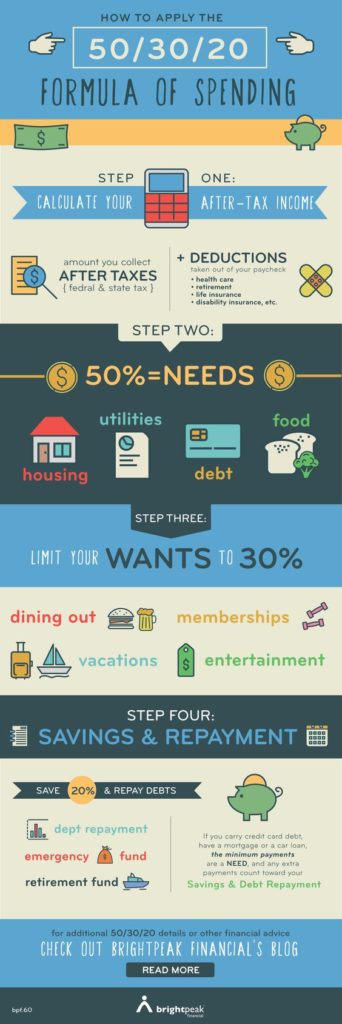Our credit counseling advice is to always budget your money. The 50/30/20 budget rule is one method which divides money between needs, wants and saving. Let’s take a look at how this type of budget works.
How to Use the 50/30/20 Budget Rule
If you are managing credit card debt and struggle to use a detailed monthly budget, a 50/30/20 budget might work for you. First, make sure you know what your net income is (the money you have after taxes and other deductions). This is the money that you will distribute throughout the budget. Follow the next three steps to complete your new budgetary system.
Step 1: Calculate Your Needs & Fixed Expenses
The 50/30/20 budget requires that you spend 50% of your budget on needs, such as utilities, consumer debt, rent and car payments. To calculate the 50%, multiply your net income by 0.50. Here is an example:
$4,000 (monthly net income) x 0.50 = $2,000/month
So based on a net income of $4,000/month, you have $2,000 to spend across your needs. The budget for a couple might look like this:
- Rent: $1,250
- Utilities: $200
- Debt: $200
- Car Payment: $300
- Gym Membership: $50
As the infographic suggests, you can also include groceries in this section of the budget if you tend to overspend on groceries and would rather make it a fixed expense. Memberships can also be placed in the next category since they aren’t essential though they are a fixed cost.
Step 2: Calculate Your Wants
The next category covers things that you want. You have 30% of your net income to spend on vacations, dining out, entertainment, clothes, maybe groceries, etc. Here is the calculation:
$4,000 (monthly net income) x 0.30 = $1,200/month
Some of these items are definitely needs. However, the amount you spend can change from month to month. You may need clothes one month, but not the next three months. Similarly, you may need to eat out more in one month and buy groceries in relation to that.
If you are working on eliminating credit card debt, this section of the budget is something you could take from to help boost your repayment efforts. Trimming these categories is a smart way to rework the budget rather than unnecessarily sacrificing other financial priorities.
Step 3: Calculate Your Financial Goals
Finally, you are left with the remainder of your money to use toward financial goals. This includes retirement, building an emergency fund, and any additional debt management efforts. You can either do some subtraction or stick to the same calculation method we have been using.
$4,000 (monthly net income) x 0.20 = $800/month
50/30/20 Budget Review
The 50/30/20 budget is just one method to manage your finances. Remember, the framework for the budget is 50% on needs and fixed expenses, 30% on wants and 20% on financial goals. You can always adjust the percentages of the categories as needed. If saving and retirement are more important, focus more money on those efforts. Simply recalculate your goals and adjust your expectations for fun.
Just like any other budget, it’s also important to track your spending. Reviewing your budget at the end of every month is the only way to know if your budget is actually working.
If you’re struggling to pay off debt, ACCC can help. Schedule a free credit counseling session with us today.







